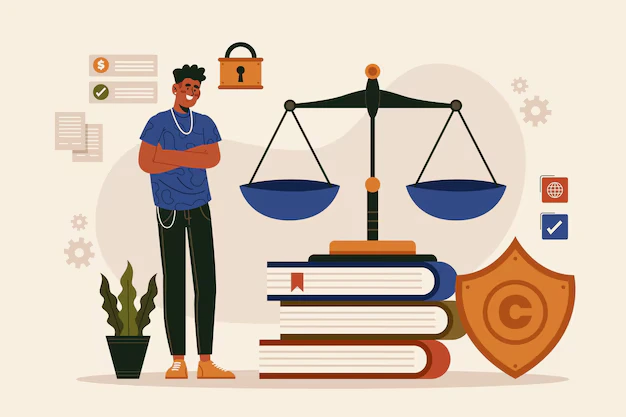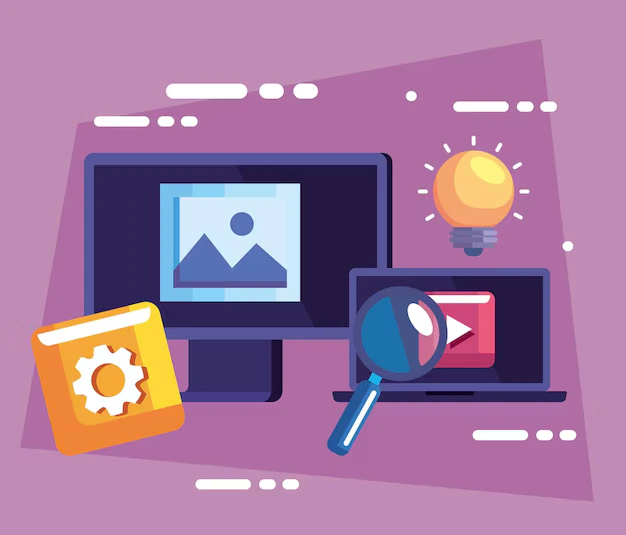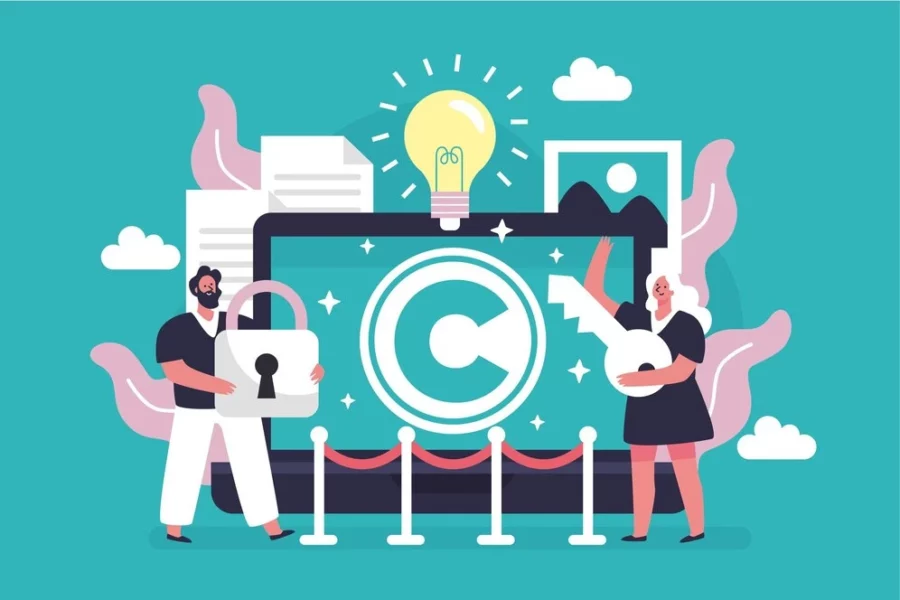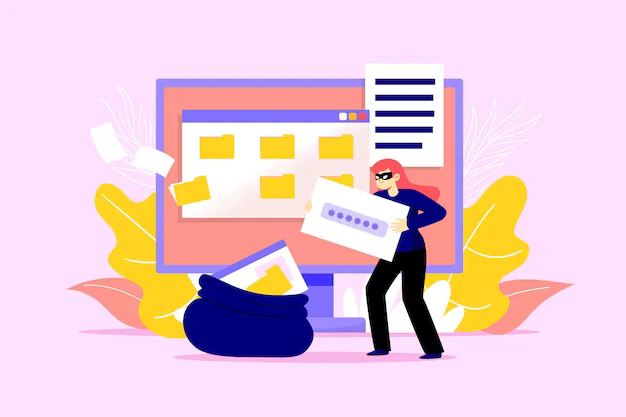Key Takeaways:
- To avoid copyright infringement, ensure that the pictures used on your blog are either your own, licensed (through platforms like Creative Commons or stock photo sites), or explicitly allowed for reuse by the copyright holder.
- While you may be able to use images under “fair use” for purposes like commentary or education, this is often a grey area. Always consider the context and the amount of the image used, as fair use is not guaranteed.
- If you are using licensed images or images under a Creative Commons copyright, always provide proper attribution, as required by the license. Failing to do so can still result in copyright claims even if the image is otherwise free to use.
Amazing images that grab readers’ attention are the lifeblood of millions of blog posts.
However, the attraction of attractive images may have a double-edged effect, sometimes guiding bloggers into legal hot water.
Let’s dive into the important world of blog pictures copyright, which is something that every content writer, from passionate amateurs to savvy business bloggers, has to know.
Although managing this complex web of regulations may seem overwhelming. Together, we will explore the complexities of copyright. Also, let’s explore about how to use images lawful.
This article serves as your guide, whether you’re confused about copyright fundamentals or want to find a gold mine of free, authorised images.
Are you prepared to turn your blog into a visual feast without breaking the copyright law? Now, let’s get started!
Protect Your Brand & Recover Revenue With Bytescare's Brand Protection software
What is Copyright?
Copyright is a legal right that grants the creator of an original work exclusive rights to its use/ distribution. This implies that, unless they decide to sell or give them away, the creator of a picture owns the rights to it.
The same rule applies to blog pictures. When you use someone else’s image without permission, you are violating their copyright. This could land you in legal hot water.
The nature and scope of copyright protection is broad. It covers various forms of creative expression including photographs, illustrations, digital art, or even memes.
Copyright protection is automatic; that is, a work is protected by copyright law from the time it is created and fixed in a physical form. This means that an image is protected even if there isn’t a copyright mark.
Copyright laws vary by country, but most nations adhere to international copyright treaties, providing a degree of global protection.
In the United States, for instance, the duration of copyright protection lasts for the creator’s lifetime plus an additional 70 years. During this period, the copyright holder has the exclusive right to reproduce, distribute, perform, display, or create derivative works based on the original source.
This indicates that it is a violation of copyright policies to use an image that bloggers found on the internet by just searching and posting it without permission.
Even if you credit the source, it’s still infringement unless you have explicit permission or the image is under a license that allows such use.
Comprehending these details is essential for maintaining the integrity of your blog and respecting the rights of original creators.
How Copyright Applies to Blog Pictures?
When it comes to blog images, copyright law is very important since it affects both bloggers’ rights to utilise other people’s work and protect their own. Applicable Copyright to blog images are as follows:
- Original Creation: Any photograph or image created by an original owner is automatically protected by copyright, even without formal registration. Bloggers who take their own photos have immediate rights to those images.
- Usage Rights: It’s illegal to use images copyrighted images on a blog without permission. This includes images that you see on other websites, on social media, or via search engines.
- Fair Use: In the “fair use” doctrine, copyrighted images may sometimes be used for commentary, criticism, or educational purposes. Fair use is subject to significant limitations. Hence, it should not be relied upon without legal advice.
- Licensing: Many images are available under different types of licenses, like Creative Commons, which allow for specific types of use. With a clear understanding of copyright licenses, bloggers are required to strictly follow these licensing conditions.
- Public Domain: Images in the public domain are free for anyone to use without permission. These typically include very old works or those explicitly released into the public domain.
- Consequences of Copyright Infringement: Using copyrighted images without permission can lead to legal action, including copyright infringement penalties, takedown notices, or lawsuits.
- Protecting Your Own Images: Bloggers can protect their original images by adding watermarks, using copyright infringement notices, and actively monitoring for unauthorised use.
Protect Your Brand & Recover Revenue With Bytescare's Brand Protection software
Common Misconceptions About Copyright

Misconceptions about copyright law are common among bloggers, and they may result in unintentional infringement. Here are some common myths debunked:
- If it’s on the internet, it’s free to use. This is perhaps the most dangerous misconception. Just because an image is easily accessible online doesn’t mean it’s free for the taking.
- Giving credit is enough. While crediting the source is good practice. But it doesn’t replace the need for permission or proper licensing.
- I can use any image for educational videos. While fair use does cover some educational uses, it’s not a blanket protection for all educational contexts.
- Small-scale use won’t matter. Copyright law applies regardless of the size of your blog or the number of people who might see the image.
- Altering an image makes it okay to use. Modifying a copyrighted image doesn’t necessarily make its use legal. Creating derivative works is also a right reserved for the copyright holder.
- If there’s no copyright symbol in the content, it’s not protected. Copyright protection is automatic upon creation, with or without a visible notice.
- I can always claim ignorance. Lack of knowledge about copyright law is not a valid defense against infringement claims.
- Everything on Creative Commons is free to use however I want. Different Creative Commons licenses have different restrictions. Always check the specific license terms.
The Consequences of Using Copyrighted Images Without Permission
Using copyrighted material without proper authorisation can lead to serious repercussions for bloggers. The consequences can be from mild to severe, depending on the copyright holder’s approach:
Takedown Notices
Copyright owners may issue (Digital Millennium Copyright Act) DMCA copyright infringement takedown notices. It requires you to remove the infringing content immediately.
Legal Action
You could be sued for copyright infringement in a more serious case. Even if you reach an out-of-court settlement, this could lead to huge legal fees.
Financial Penalties
You can be required to pay damages if you are found guilty of copyright infringement. These can range from $750 to $30,000 per work infringed, and up to $150,000 per work if the infringement is deemed willful.
Reputation Damage
It might be damaging to your blog’s reputation to be found accused of violating copyright.
Loss of Ad Revenue
Receiving repeated copyright complaints might result in your account being suspended by sites like Google AdSense. This could cut off money from ads.
Website Shutdown
Repeated violations could lead to your hosting provider shutting down your website in some serious cases.
Criminal Charges
While rare for bloggers, willful copyright infringement on a large scale can lead to criminal charges.
Time and Stress
It might take a lot of time to handle copyright issues. This prevents you from growing your blog content.
Protect Your Brand & Recover Revenue With Bytescare's Brand Protection software
Types of Copyrighted Images

Rights-Managed Images
These are licensed for specific, limited use. The license typically restricts factors like duration of use, geographic location, industry, and the type of media where the image appears.
For bloggers, this might mean licensing an image for use in a single blog post for a set period. While often high-quality, rights-managed images can be expensive and require careful tracking to ensure compliance with license terms.
Royalty-Free Stock Photos
Despite the name, these usually require an initial payment. However, once purchased, you can use the quality stock photos multiple times without additional fees.
The license is typically broader than rights-managed, allowing use across various projects. Be aware that “royalty-free” doesn’t mean copyright-free images – usage restrictions may still apply.
Creative Commons Licensed Content
These offer a spectrum of permissions, from very restrictive to nearly unlimited use. Some of the common types of copyright license include:
- Attribution (CC BY): Allows use with credit to the creator.
- Attribution-ShareAlike (CC BY-SA): Allows use & modifications if you share under the same license.
- Attribution-NoDerivs (CC BY-ND): Allows use without modifications.
- Attribution-NonCommercial (CC BY-NC): Allows non-commercial use only.
Where to Find Free and Legal Images for Your Blog?
Finding free & legal images for your blog is essential to avoid copyright issues. There are several reliable sources to access high-quality, blog royalty-free images without any legal concerns:
Public Domain Images
It is not protected by copyright. Because the copyright has expired or the creator has released the work into the public domain. You can use these images without copyright restrictions. Sites for images like Wikimedia Commons & PublicDomainPictures offer a wide collection of images.
Free Stock Photo Websites
Many websites provide free blog stock photos under licenses like Creative Commons Zero (CC0). It allows you to use, modify, and distribute the images without asking for permission.
Popular platforms include Unsplash, Pexels, and Pixabay. These stock image websites compile high-quality photos from photographers across the globe that cover a variety of topics.
Google’s Image Search Filters
It allows you to search for images labeled for reuse. After searching for an image, click on “Tools,” then under “Usage Rights,” select the option, such as “Labeled for reuse.” This makes sure your blog posts only use images that are freely accessible.
How to Avoid Copyright Infringement?
Avoiding copyright infringement issues is essential when using images, text, or other media online. Let’s explore how to avoid copyright infringement here:
Use Royalty-Free/ Licensed Images
Always choose images from platforms that offer royalty-free content, like Unsplash, Pexels, or Pixabay. Make sure the license allows commercial usage in the case that your blog generates revenue. Don’t use images from Google or other websites without verifying their use rights.
Comprehend Fair Use
Fair use permits limited use of copyrighted material for specific purposes like education, criticism, or commentary. However, this is a gray area, and it’s safer to avoid using copyrighted images unless you have explicit copyright permission.
Credit the Source When Required
Some licenses, like Creative Commons Attribution, require that you give credit to the image’s creator. Make sure to follow the exact terms of the license, including proper attribution format.
Create Your Original Content
One of the safest ways to avoid infringement is to create your own images. This way, you have complete control over the usage rights.
Consider Paid Stock Images
Platforms like Shutterstock/ Adobe Stock offer paid options. Here the licensing terms are clear and you are granted broad usage rights.
Copyright for International Bloggers

International copyright law can vary across countries, but international bloggers must adhere to basics of copyright principles to avoid infringement, actions especially since online content reaches global audiences. Here’s what bloggers should know about international copyright infringement:
Berne Convention
Ideal world copyright are signatories to the Berne Convention copyright for the Protection of Literary work copyright and artistic works copyright, which means copyright protection is automatically extended across international borders. If a work is copyrighted in one member country, it’s protected in all other member countries without requiring copyright registration.
Universal Copyright
Copyright protection applies automatically upon creation, even if a work isn’t explicitly marked with a copyright symbol. Bloggers must avoid assuming that content without a copyright notice is free to use.
Fair Use and Fair Dealing
Some countries, like the U.S., recognise Fair Use, allowing limited use of copyrighted material for education or commentary. Others, like Canada and the UK, use Fair Dealing, which is more restrictive. Bloggers should be aware of how these laws apply to their country of residence and to the content they use.
Obtaining Permissions
If in doubt, always seek permission from the content creator. Licensing agreements from platforms offering royalty-free ensure international compliance.
How to Legally Protect Your Own Blog Images?
Protecting your blog images legally is essential to maintain ownership and control over their use.
Copyright Ownership
You automatically own the copyright upon creation under international law, including the Berne Convention. However, explicitly stating that your images are copyrighted, along with the copyright symbol (©), your name, and the year of creation, reinforces your ownership.
Watermark Your Images
Adding watermarks in image editing with your blog name or logo is an effective way to deter unauthorised use. It establishes ownership by making it more difficult for someone else to use the image without giving you credit.
Register Copyright
In some countries, like the U.S., registering your images with the copyright office adds an extra layer of protection. It is not required. But if you do decide to pursue legal action for infringement, it offers benefits including statutory damages.
Use Licensing Terms
Define the terms under which others can use your images. Consider crafting your own terms, detailing whether others can use, modify, or share your images and how they should credit you.
Monitor Unauthorised Use
Use tools like Google’s Reverse Image Search to track if your images are being used without permission. If infringement occurs, you can issue a DMCA takedown notice to have the content removed.
What to Do if You’ve Used a Copyrighted Image?

If you have used a copyrighted image on your blog without knowing, it’s important to act quick to avoid potential legal repercussions.
Remove the Image Immediately
As soon as you realise the image is copyrighted and used without permission, take it down from your blog or any other platforms where it was shared. This reduces the risk of copyright claims against you.
Reach Out to the Copyright Owner
Speak with the copyright owner to talk about the situations. Express regret for the accidental usage of the image and request permission from the owner to use it further. If asked, be ready to pay a licence fee. Some creators may grant proper permission retroactively, particularly if you offer proper credit or compensation.
Replace the Image with a Legal Alternative
Replace the copyrighted image with one that’s free for commercial use, such as from websites like Unsplash, Pexels, or Pixabay. Ensure the replacement image is properly licensed, and follow the required usage terms, like giving attribution if needed.
Comprehend the Consequences
In some cases, you might receive a cease and desist letter or a demand for payment. Avoid ignoring these; work toward a resolution. Settling the matter is less expensive than a copyright infringement lawsuit.
Learn from the Experience
Always verify the usage rights of images before using them. Consider creating your own image to avoid future issues.
The Role of AI in Copyright and Blog Images
AI plays an significant role in copyright issues of blog images, from their creation to detection of misuse.
AI-Generated Images and Copyright
With tools like DALL-E and MidJourney, bloggers can now create unique images using AI. AI-generated images’ copyright status is still up for debate. In many jurisdictions, works created by AI may not be eligible for copyright protection unless there’s significant human input. This creates ownership issues since these technologies often use datasets containing copyrighted material.
Content Creation and Personalisation
AI tools allow bloggers to generate customised images for specific content. Bloggers can use AI to create custom visual content on their own by reducing reliance on stock photos. Additionally, there is less chance of using copyrighted content unknowingly.
Detecting Copyright Infringement
AI is also used to detect unauthorised use of images. Tools like Google’s Reverse Image Search use AI algorithms to scan the web for image misuse. It helps original creators protect their copyrighted works.
Automating Licensing
AI platforms can streamline the licensing of images with automated systems that monitor usage rights & licenses. It also ensure that bloggers follow copyright laws.
What’s Next?
Copyright plays a essential role in protecting the visual content on your blog.
Knowing copyright laws is essential to ensure that you stay compliant, whether you’re using AI-generated images or your original images.
It’s essential to be mindful of the rights attached to every image you use and to take proactive steps to protect your own images from unauthorised use.
By following best practices, you can maintain the integrity of your blog while respecting the intellectual property of others.
Your original content is constantly vulnerable to unauthorised use. Bytescare leverages advanced AI technology to detect, remove, and monitor the illegal distribution of your content 24/7.
Bytescare digital piracy monitoring service protects your intellectual property, giving you peace of mind to focus on creativity and growth.
Don’t let piracy diminish the value of your hard work—secure your digital assets with Bytescare and take control of your online presence. Ready to safeguard your content? Book a demo with us today.
The Most Widely Used Brand Protection Software
Find, track, and remove counterfeit listings and sellers with Bytescare Brand Protection software

FAQs
Can I use any image I find on the internet for my blog?
No, you cannot use any image you find on the internet for your blog without permission.
Most of the pictures online are protected by copyright laws, which means using them without permission can lead to copyright infringement.
What is the safest way to use an image from the internet on my blog?
The safest way to use an image from the internet on your blog is by obtaining explicit permission from the image owner or using pictures from royalty-free websites, such as Unsplash, Pexels, or Pixabay.
Even then, it’s important to adhere to the terms of use specified by these platforms.
What is ‘fair use’ in terms of using blog pictures?
‘Fair use’ is a legal doctrine that promotes freedom of expression by permitting the unlicensed use of copyright-protected works in certain circumstances, such as criticism, comment, news reporting, teaching, scholarship, and research.
However, it’s a complex law and varies by country. Therefore, it’s advised to consult with a legal expert before assuming your use of a copyrighted image falls under ‘fair use’.
How can I give proper credit to an image I use on my blog?
To properly credit an image, you should mention the name of the creator and provide a link back to the source of the image.
The format can look something like this: “Photo by [Photographer’s Name] via [Platform/Website Name]”.
Always check the specific requirements for attribution on the platform where you found the image, as these can vary.
What can happen if I use copyrighted pictures without permission on my blog?
If you use copyrighted pictures without permission on your blog, it could lead to copyright infringement.
Consequences may include receiving a cease and desist letter, having your website taken down via a DMCA (Digital Millennium Copyright Act) notice, or even facing legal action which could result in hefty fines.
It’s always best to respect copyright laws and only use pictures you have permission to use.
Can I modify a copyrighted image and use it on my blog?
No, modifying a copyrighted image does not automatically grant you the right to use it on your blog.
Even if you make significant changes, the original image is still protected by copyright, and using it without permission can lead to copyright infringement.
Always seek explicit permission from the copyright owner or use images licensed for modification, such as those under a Creative Commons license that allows alterations.
Ready to Secure Your Online Presence?
You are at the right place, contact us to know more.

